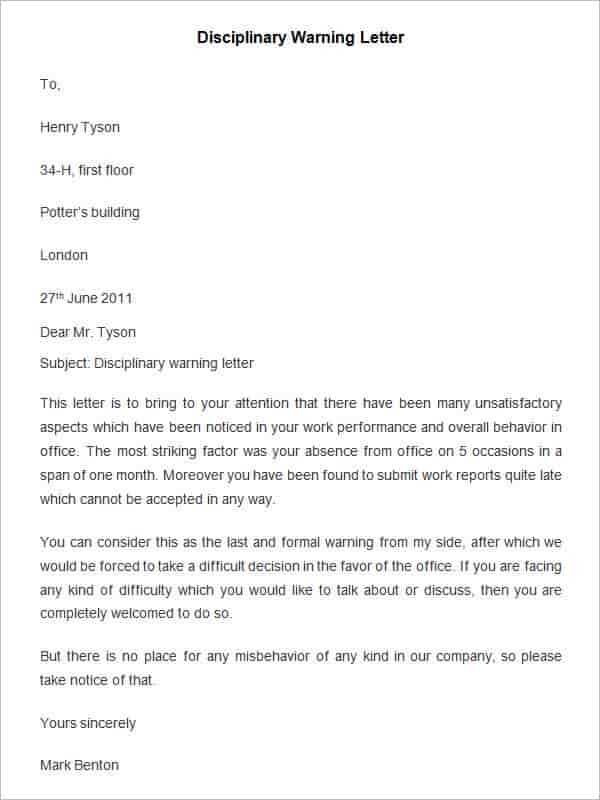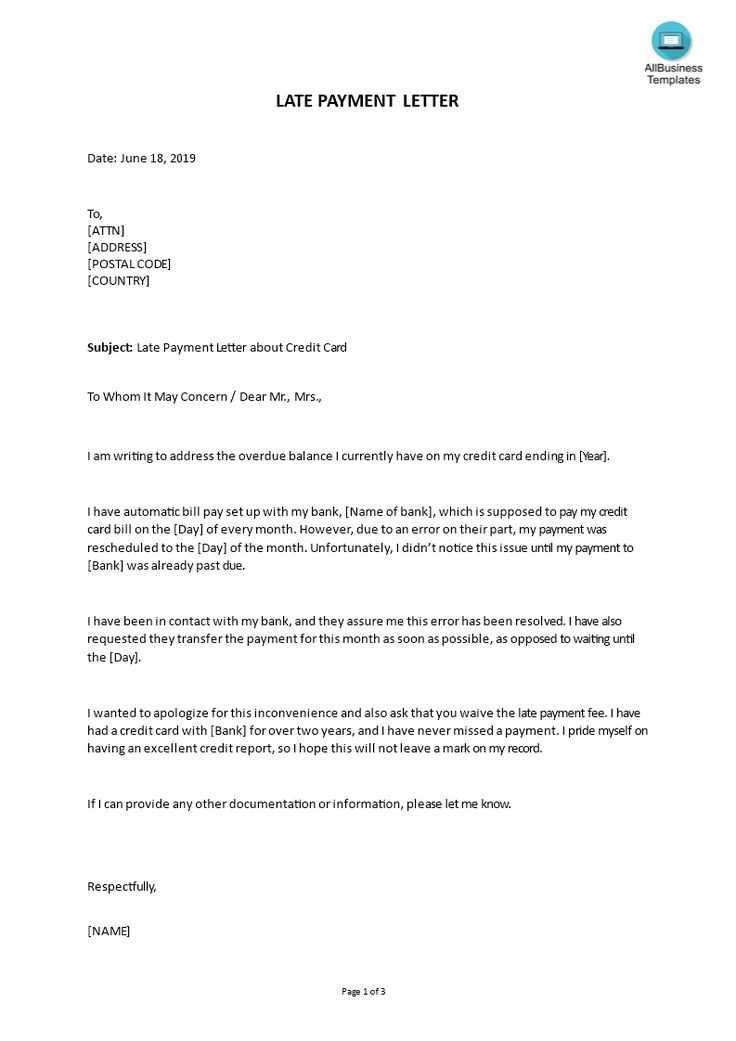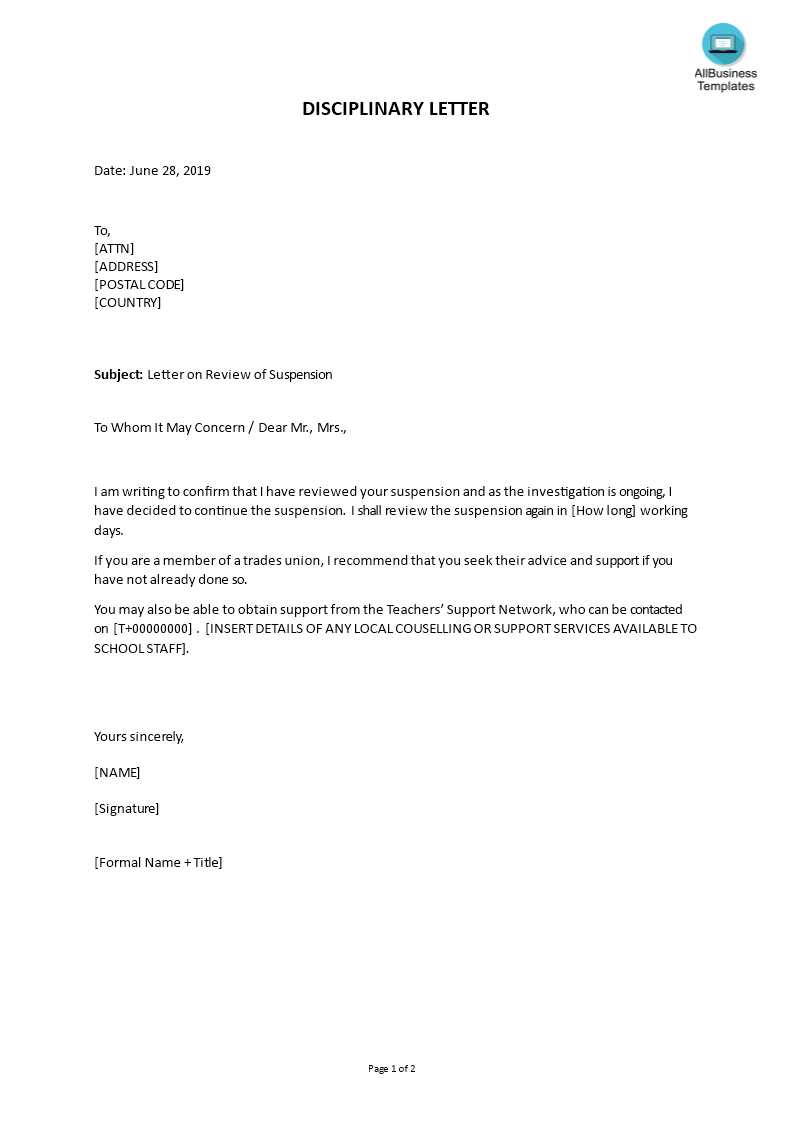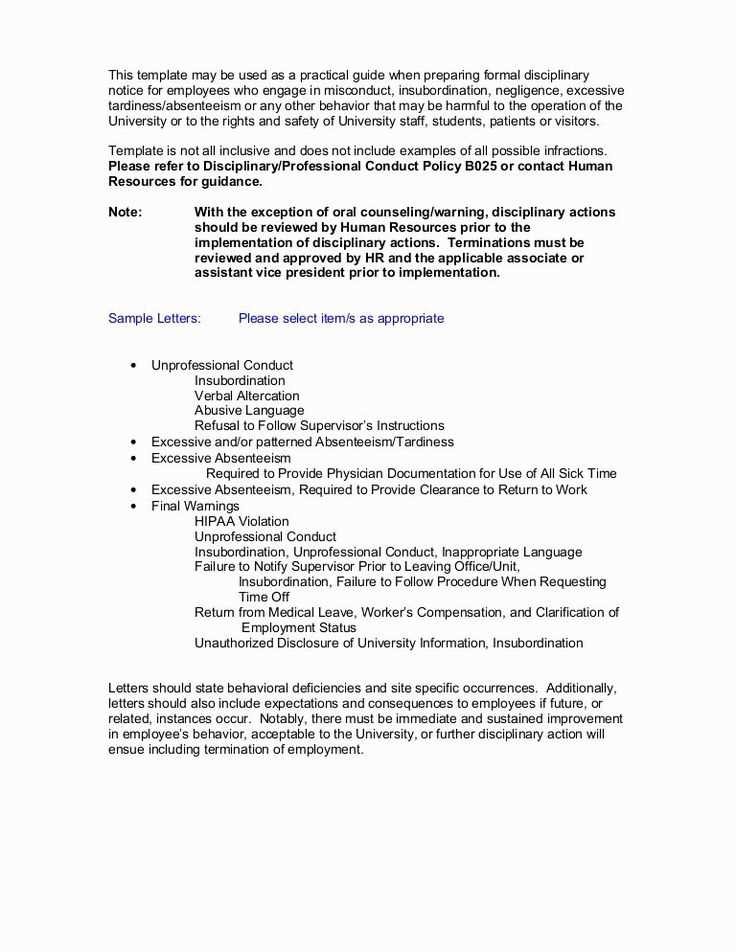Disciplinary Letter Template for Professional Use

In any workplace, addressing performance or behavioral concerns with employees is essential for maintaining a positive and productive environment. Clear and professional communication is key to ensuring that any issues are addressed fairly and constructively.
When dealing with employee misconduct or performance shortcomings, having a written record is crucial. A formal document provides clarity, sets expectations, and helps both parties understand the necessary steps to resolve the situation.
By using a well-crafted document, employers can ensure that they are following appropriate procedures while also offering employees an opportunity to correct their behavior. This approach promotes transparency, fairness, and mutual respect in the workplace.
Disciplinary Letter Template Overview
When addressing workplace issues, having a structured and professional approach is essential. A well-organized document helps communicate expectations and the necessary actions to resolve any conflicts or performance concerns. This tool serves as a formal record and guides both employers and employees through the steps toward improvement or resolution.
Key Features of a Professional Document
The document should be clear, concise, and fair, outlining the specific issue, the steps taken to address it, and any potential consequences if the situation doesn’t improve. It should also include a section for employee input, allowing for a two-way conversation.
Structure of the Written Record

| Section | Description |
|---|---|
| Introduction | Provide context for the communication and explain the reason for the document. |
| Issue Description | Detail the behavior or performance problem, with examples where possible. |
| Actions Taken | Summarize prior steps taken to address the problem, such as verbal warnings or meetings. |
| Expectations Moving Forward | Outline the desired changes and the steps the employee must take to improve. |
| Consequences | Describe the potential outcomes if improvement is not observed. |
This document serves not only as a tool for improvement but also as a safeguard for both the employee and the employer, ensuring that all actions are documented and transparent.
Why Use a Formal Letter

Written communication plays a vital role in addressing workplace concerns, providing a clear and documented record of the issue at hand. A structured document helps both parties involved understand the expectations, responsibilities, and next steps in resolving a problem, promoting accountability and transparency.
Clarity and Precision
A formal written document ensures that the message is clear and precise, leaving little room for misunderstanding. It allows employers to outline specific issues, expectations, and consequences in an organized manner, reducing the risk of miscommunication.
Legal Protection
Documentation of actions taken helps protect both the employer and the employee. In the event of further disputes or legal proceedings, having a formal record can serve as evidence of fair treatment and compliance with workplace policies. It also provides employees with a clear understanding of their rights and obligations.
In addition, formal communication fosters respect and professionalism within the organization, setting a standard for handling all workplace matters with care and consideration.
Essential Parts of a Letter
A well-structured written communication is crucial when addressing workplace concerns. Each section serves a specific purpose, helping to clearly convey the issue, expectations, and potential outcomes. Understanding the key components ensures that the message is professional, effective, and fair.
Introduction and Purpose
The opening section sets the tone for the document, explaining why it has been created and briefly describing the situation. This part should be concise, direct, and neutral, stating the reason for addressing the issue while maintaining professionalism.
Details of the Issue
The body of the communication focuses on describing the specific problem at hand. This section should include examples of the behavior or performance that needs attention. It’s important to be factual, objective, and clear, avoiding any emotional or subjective language.
Expectations and Next Steps
This part outlines the improvements or changes expected from the individual. It should be clear and actionable, providing a timeline for when these adjustments need to occur. Specific goals and measurable outcomes help both parties understand the desired results and the path forward.
Consequences of Non-Compliance
Lastly, the document should explain the potential repercussions if the required changes are not made. While this section should remain professional, it is important to be clear about the seriousness of the situation and the possible outcomes if expectations are not met.
Step-by-Step Writing Guide
Creating a formal written document to address workplace issues requires careful attention to structure and clarity. By following a step-by-step approach, you can ensure that the message is communicated effectively and professionally. The following guide outlines the key stages in crafting a well-organized communication.
- Begin with a Clear Introduction: State the purpose of the document and the reason for its creation. Be direct yet neutral to avoid any ambiguity.
- Describe the Issue: Provide a detailed account of the behavior or performance that is being addressed. Use specific examples to clarify the situation.
- Set Clear Expectations: Clearly outline the changes or improvements that need to be made. Use precise language to avoid confusion and provide actionable steps.
- Explain the Consequences: Detail the potential outcomes if the expectations are not met. Ensure the tone remains professional while making the seriousness clear.
- Offer Support or Assistance: In some cases, it may be helpful to include a section offering guidance, training, or support to help the employee improve.
- Conclude with a Call to Action: Encourage the individual to take the necessary steps to resolve the issue and remind them of the importance of meeting the outlined expectations.
By following these steps, you can create a clear, professional document that fosters understanding and promotes positive changes in the workplace.
Handling Difficult Employee Situations
Dealing with challenging behavior or performance issues in the workplace requires careful management and thoughtful communication. It’s essential to approach these situations with professionalism, aiming to resolve the issue while maintaining a respectful and productive work environment.
Approaching the Situation Calmly
When addressing difficult situations, it’s important to stay calm and composed. Reacting emotionally can escalate the issue and make it harder to find a resolution. Instead, focus on understanding the root cause of the problem and approach the individual with an open mind. This can help foster a collaborative atmosphere where both parties feel heard.
Clear Communication and Expectations

Effective communication is crucial in addressing workplace issues. Be clear about the behavior or performance that needs improvement, and ensure that the expectations for change are understood. Offering specific examples and setting achievable goals can help guide the individual in making necessary adjustments. It’s important to be transparent about the potential consequences if the situation does not improve, ensuring that all parties are on the same page.
Best Practices for Clarity and Tone
When addressing sensitive workplace issues, it is crucial to maintain both clarity and an appropriate tone. Clear communication ensures that the intended message is easily understood, while the right tone helps preserve professionalism and respect. Striking the right balance is key to ensuring that the message is received constructively.
To ensure clarity, use precise and straightforward language. Avoid ambiguous terms or overly complex sentences, as these can lead to confusion or misinterpretation. It’s important to be specific about the issue at hand, providing concrete examples and actionable steps for improvement.
The tone should always be professional and neutral. Even when addressing negative behavior or performance, avoid using accusatory or overly harsh language. Instead, focus on facts and maintain a tone that is respectful and supportive, while still being firm about the expectations moving forward.
Legal Guidelines to Follow
When addressing workplace issues formally, it is essential to be aware of the legal aspects involved in the process. Ensuring compliance with employment laws protects both the employer and the employee, helping to avoid potential disputes or legal consequences. Understanding and adhering to these guidelines is crucial for maintaining fairness and transparency.
Key Legal Considerations
- Consistency: Ensure that similar issues are addressed consistently across all employees to avoid claims of discrimination or unfair treatment.
- Documentation: Keep a clear record of all communications, warnings, and actions taken. This documentation can serve as evidence if the issue escalates.
- Privacy: Respect employee confidentiality when handling sensitive matters. Only share information with those who need to be involved in the resolution process.
Steps to Ensure Compliance
- Review company policies: Familiarize yourself with your organization’s rules and procedures to ensure that all actions taken are in line with established protocols.
- Provide warnings: Where appropriate, give employees sufficient time to correct their behavior before taking more formal actions.
- Consult legal counsel: If you are unsure about the legality of any steps in the process, seek advice from legal professionals to ensure compliance with local labor laws.
By following these legal guidelines, employers can create a fair and compliant process that addresses workplace issues while respecting employees’ rights.